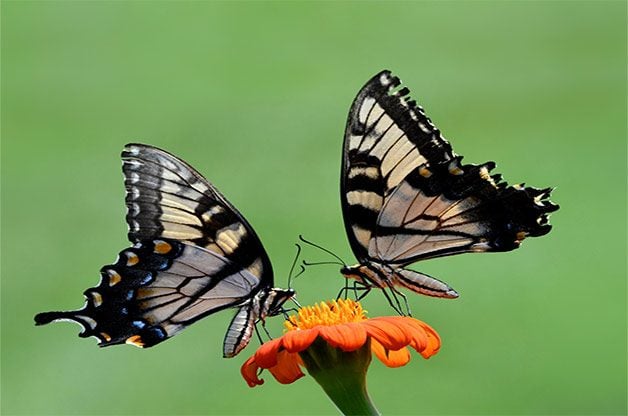5 Basic Butterfly Behaviors to Know
Updated: May 19, 2020

Take your butterfly gardening to the next level by learning some of their most common habits to look for.
It’s such a treat to see butterflies in your backyard. But it seems that almost as quickly as they flit in, they dart off again, leaving you with barely a glimpse. These fascinating fliers, however, have characteristic habits that can help you spot more of them! Here are a few things to look for when you’re in butterfly territory.
1. Why Butterflies Bask in the Sun
Butterflies are ectotherms, which means they rely on external sources for body heat. In the morning, and throughout cooler days, they must spend time in the sun with their wings spread, raising their body temperature to roughly 85 degrees before they can fly. A few minutes of basking in the sunshine raises their temperature as much as 20 degrees above the surrounding air.
2. Butterfly Flight Patterns
Butterflies have four wings, two on each side of their body. These are connected in such a way that the wings can move independently, allowing a wide variety of flight patterns. Some species soar slowly, with only a few wing flaps, while others seem to dart in every direction at once. Experienced butterfly watchers can often identify a species from a distance just by noting the pattern of its flight.
3. How Butterflies Mate

Most butterflies have only a few short weeks to mate before they die. A male finds another butterfly of the same species by sight, then determines its sex by flying close to detect chemical pheromones—a process that often makes them look like they’re dancing around each other in the air. A male and female mate by clasping the ends of their abdomens together, remaining that way for up to 12 hours so the male can be sure no competitor has a chance to fertilize “his” eggs. The female often flies off to continue feeding, which is why you’ll sometimes see two butterflies seemingly stuck together as they fly by. In a day or two, the female lays her eggs one at a time on the appropriate host plant by landing and bending her abdomen up to deposit them.
4. What Do Butterflies Eat?
Most butterfly species drink nectar from flowers, but some prefer fruit juices, tree sap and even dung or carrion. Regardless of the source, they feed with their proboscis, which curls up when not in use. Butterflies extend the proboscis into the liquid, drawing it up into the body. A few also have the ability to digest pollen gathered on the proboscis, giving these species longer life spans. Butterflies also need salts and other nutrients, which they get by drinking from puddles or muddy spots, an activity known as puddling. (Read more: 8 Super Fragrant Flowers Butterflies and Other Pollinators Love)
5. Do Butterflies Sleep?
Butterflies don’t exactly sleep, but they do rest, usually with their wings closed. The undersides of the wings are patterned to provide excellent camouflage, allowing them to land and seemingly disappear from sight—a near-perfect way to elude predators. (Read more: Watching Butterflies)
3 Steps to Creating a Butterfly Habitat
- Choose the right plants. Nectar plants feed adult butterflies, while caterpillars require specific host plants. Often they are different. You can ask your local extension office for ideas.
- Provide shelter and sunshine. Grasses, shrubs and piles of rocks or branches give butterflies places to rest. Flat rocks let them bask in the sun.
- Avoid pesticides (even “natural” ones). Learn to tolerate a few pests to allow butterflies to thrive.





















